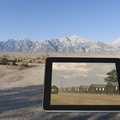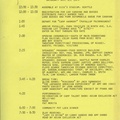Loyalty Registration After

The purpose of the loyalty registry was to separate those who were loyal to America from those who were not, to encourage those confirmed as loyal to America to serve in the military or to return quickly to American society through work or studies, and to isolate those deemed disloyal. However, the poorly designed questionnaire caused anxiety and confusion in the camps, so question 27, "Are you willing to serve in the U.S. Army or the Women's Army Corps?" was changed to "Are you willing to serve in the Army Nursing Corps or the Women's Army Corps?" for women, and question 28, "Will you pledge allegiance to the United States and 'renounce' your loyalty to the Japanese Emperor?" was revised to "Will you abide by U.S. laws and not take any action that would in any way hinder the U.S. war effort?" to reflect the concerns of the Issei who feared that denying their loyalty to Japan would result in the loss of their nationality without being granted American citizenship.
The results showed that of the 78,000 Japanese people aged 17 and over, approximately 6,700 were classified as "not loyal," and about 2,000 gave conditional responses. More than 65,000 people, or 83 percent of those who registered, were recognized as loyal.
No No Boy
Young people who answered "no" to both the 27th and 28th questions and were deemed disloyal to the United States were called "No-No Boys." They were mainly second-generation Japanese who had been educated in Japan. The government decided to use Tule Lake, where the proportion of No-No Boys was the highest, as an isolation camp, further tightening security and gathering all those deemed disloyal from each camp, including those who wanted to return to Japan, at Tule Lake. 1
Peggy Ayako Nagata moved to Tule Lake from Minidoka with her family when she was 10 years old, as her mother wanted to return to Japan. In Tule Lake, where many Japanese people have returned to Japan, Japanese language schools are allowed at the Japanese people's own expense, and the teachers themselves make their own textbooks using mimeograph printing. I was shown Ayako's textbooks from that time, and among the Japanese and math textbooks there was also a textbook on etiquette so that she wouldn't have any trouble when she returned to Japan, and in it was Ayako's name, Nagata Ayako, written in small, neat letters. Ayako describes what it was like at that time as follows:
Every morning before school started, we would do some exercises in the schoolyard and then go to class. When the teacher entered the classroom, we all stood up and bowed before class began. We were taught all subjects in Japanese: Japanese geography, Japanese language, manners, and arithmetic. We also took turns cleaning the classroom. It was just like Japan, wasn't it? The girls had short hair or braids like mine, and the boys had very short, spiky hair. I also joined the children's club. We would all get up early and gather before the sun rose, and then we would all bow to the rising sun. It seemed very Japanese to me. 2
Young second-generation Japanese who had returned to America formed the Hokoku Hoshidan (Houkoku Service Corps). Noboru Shirai, who was interned at Tule Lake while studying abroad, describes their activities in his book "California Japanese American Internment Camps" as follows:
All the men had their heads shaved and wore grey sweatshirts as their uniform. The female members of the Youth Corps wore what was called pigtails, with their hair divided in the middle and braided into two parts, which were not allowed to hang down on either shoulder. Both male and female members wore headbands with the Japanese flag dyed on them, so the Youth Corps was also called the "headband group" or the "shaved head group."... At 5 a.m., 1,200 people in the square first prayed for Japan's victory and performed a parade around the Imperial Palace, then performed a brave national exercise. After that, they formed into four columns and marched at full speed throughout the facility, blowing marching trumpets and yelling "Wasshoi, Wasshoi." 3
Tule Lake was a place where conflicts arose between these extremist groups and the camp commander, as well as between pro-Japanese and pro-American factions, and where riots and strikes broke out on numerous occasions. At one point, the camp was placed under military control until security within the camp calmed down. There was also a detention center within the camp. One time, an acquaintance of Ayako's father was fired from his job in the kitchen without warning, and her father complained about this to the others over a meal. The next day, someone apparently reported the matter to the authorities, and Ayako's father was arrested and spent three months in a detention center. Despite the turbulent environment, Ayako says that the children seemed to have the ability to quickly pick themselves back up, no matter what happened. 4
Conditional Answer
Bill Mambo and his wife Mary, who took the photo of Billy ( Chapter 3 of this series ) enjoying his first ice skating, gave conditional answers. According to interesting data unearthed by Eric L. Mueller from public records, when asked about his spouse's nationality, Bill answered "American?" with a question mark, when asked if he had applied to renounce his citizenship he answered "Not yet," and when asked whether he would swear allegiance to the United States and disavow his allegiance to Japan he replied, "If all [civil] rights were restored..."
When asked about her nationality, Mary replied, "American, for now, but I'm wondering about that." When asked about her spouse's race, she replied, "Japanese. It's not her fault. I'm proud of our race." When asked if she had ever sent a child to Japan, she wrote, "No, for what?", perhaps hoping to stop asking such pointless questions. When asked if she intended to join the Army Nursing Corps or the Women's Army Corps, she replied, "Yes, but why was my friend, who is a registered nurse, rejected when she applied? They needed a lot of nurses at that time." She expressed her resentment toward the military, which suddenly classified second generation Japanese as 4-C (enemy aliens) after the attack on Pearl Harbor and rejected all of their applications to join. 5 After answering "yes" to the 28th question about whether she would pledge allegiance to the United States, she also wrote, in the small space available, "I am an American by birth," expressing her dissatisfaction at being asked such an obvious question again.
The two men, who gave such conditional answers, were summoned separately to a hearing held at the camp on October 5th. Bill directly expressed his anger at the officer who questioned him, saying, "Ever since I was forcibly evicted from California, I haven't had good feelings toward the American government.... I feel like I'm being treated unfairly, even as a citizen." As for military service, he said he couldn't imagine joining the military while keeping his family locked up behind barbed wire fences, saying, "First I need to get my family home, and then I'll do it."
Meanwhile, in the room where Mary's hearing was held, the official read out the answer to the 28th question that Mary had written, and again asked her if she would pledge allegiance to the United States. Mary answered, "Yes, of course. After all, I was born here," and added, "I'm a bit of a short-tempered person, and sometimes I say things I don't need to say." When asked, "If you could choose, which citizenship would you choose, American or Japanese?" she answered, "The one I have now. I don't know anything about that country, I was born and raised here. I've always lived among white people, and I have no reason to want to go to Japan."
The Relocation Bureau headquarters concluded that Bill was "outspoken and bitter about his eviction, but not as bitter as he was before," and that Mary was "highly Americanized, angry that her loyalty to the United States was being questioned, and her answer to the loyalty question was one of protest for civil rights, not disloyalty," ultimately determining that the two were loyal to the United States.6 However , many who gave conditional answers were deemed disloyal and were sent to the Tule Lake segregated internment camp.
Notes:
1. Burton, Jeffery F., et al. Confinement and Ethnicity: An Overview of World War II Japanese American Relocation Sites . Western Archeological and Conservation Center, National Park Service, US Department of the Interior, 1999.
At that time, about 6,000 loyalists who were in Tule Lake were transferred to other camps, but 4,000 loyalists remained, preferring to stay in a familiar environment rather than being transferred to another camp, so the population temporarily swelled to more than 18,000.
2. Peggy Ayako Nagata Tanemura, interview by Yuri Brockett and Jenny Hones, November 21, 2013 at Seattle, WA.
3. Noboru Shirai, "California Japanese Internment Camps," Kawade Shobo Shinsha, 1941
4. Peggy Ayako Nagata Tanemura, interview by Yuri Brockett and Jenny Hones, November 21, 2013 at Seattle, WA.
5. However, in 1943, the Nisei were once again placed in the 1-A classification, eligible for military service, and volunteers were recruited.
6. Muller, Eric L. (Ed.). Colors of Confinement: Rare Kodachrome Photographs of Japanese American Incarceration in World War II . Chapel Hill: University of North Carolina Press, 2012.
*Reprinted from the 136th issue (February 2014) of “Children and Books,” a quarterly magazine published by the Children’s Library Association.
© 2014 Yuri Brockett






